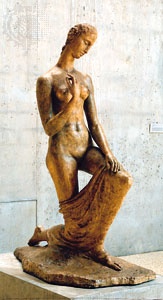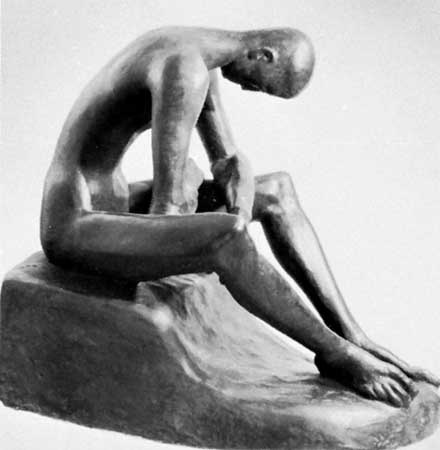Lehmbruck, Wilhelm
German artist
born January 4, 1881, Meiderich, near Duisburg, Germany
died March 25, 1919, Berlin
German sculptor, printmaker, and painter best known for his melancholy sculptures of elongated nudes.
Lehmbruck studied art in Düsseldorf, Germany, first at the School of Arts and Crafts (1895–1901) and then at the Art Academy (1901–07). His early work was academic and conservative; he was strongly influenced by the monumental works of the French sculptor Auguste Rodin (Rodin, Auguste), as seen in Lehmbruck's The Bather (1905) and his life-sized Mankind (1909).
 In 1910 Lehmbruck moved to Paris, where he executed not only sculptures but also a number of paintings, etchings, and lithographs. The rounded, simplified forms of his sculpture Standing Woman (1910) reveal his new enthusiasm for the calm Classicism of the French sculptor Aristide Maillol (Maillol, Aristide). In this sculpture, the idealized face is softly modeled and evokes a sensitive, introspective mood. Lehmbruck's style became less naturalistic and more psychologically powerful with sculptures such as Kneeling Woman (1911). The harmonious repose of this figure's angular, elongated limbs and her melancholy facial expression suggest a resigned pessimism, an attitude that characterizes Lehmbruck's mature works.
In 1910 Lehmbruck moved to Paris, where he executed not only sculptures but also a number of paintings, etchings, and lithographs. The rounded, simplified forms of his sculpture Standing Woman (1910) reveal his new enthusiasm for the calm Classicism of the French sculptor Aristide Maillol (Maillol, Aristide). In this sculpture, the idealized face is softly modeled and evokes a sensitive, introspective mood. Lehmbruck's style became less naturalistic and more psychologically powerful with sculptures such as Kneeling Woman (1911). The harmonious repose of this figure's angular, elongated limbs and her melancholy facial expression suggest a resigned pessimism, an attitude that characterizes Lehmbruck's mature works. At the outbreak of World War I Lehmbruck returned to Germany, where he worked in a hospital. His experiences with wounded and dying soldiers led him to create such poignant works as The Fallen (1915–16) and Seated Youth (1918), which indicate the artist's state of utter depression. He committed suicide one year later. Although he was not involved in the German Expressionist (Expressionism) movement, the emotionalism and elongated features of his sculptures have led critics and historians to associate Lehmbruck with Expressionism.
At the outbreak of World War I Lehmbruck returned to Germany, where he worked in a hospital. His experiences with wounded and dying soldiers led him to create such poignant works as The Fallen (1915–16) and Seated Youth (1918), which indicate the artist's state of utter depression. He committed suicide one year later. Although he was not involved in the German Expressionist (Expressionism) movement, the emotionalism and elongated features of his sculptures have led critics and historians to associate Lehmbruck with Expressionism.- Feodor Lynen
- Feodosiya
- Feofan Prokopovich
- feoffment
- Feoktistov, Konstantin Petrovich
- Ferahan carpet
- Feraoun, Mouloud
- Ferber, Edna
- ferberite
- Ferde Grofé
- fer-de-lance
- Ferdinand
- Ferdinand Alphonse Hamelin
- Ferdinand Berthoud
- Ferdinand Braun
- Ferdinand Christian Baur
- Ferdinand Cohn
- Ferdinand de Saussure
- Ferdinand E. Marcos
- Ferdinand Foch
- Ferdinand Freiligrath
- Ferdinand Gotthold Max Eisenstein
- Ferdinand, Graf (count) von Zeppelin
- (Ferdinand Gustav) Julius von Sachs
- Ferdinand Hiller